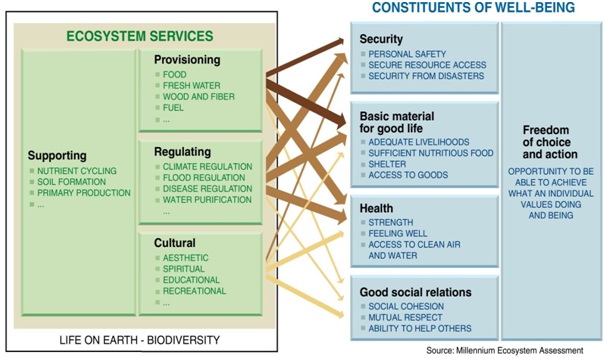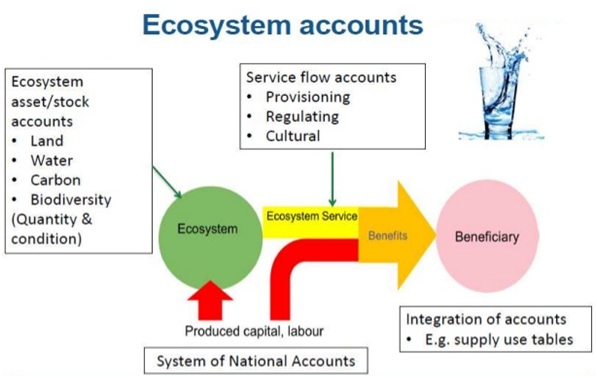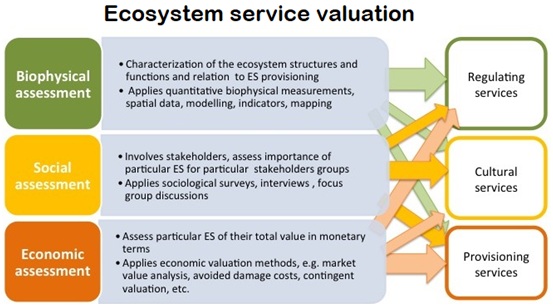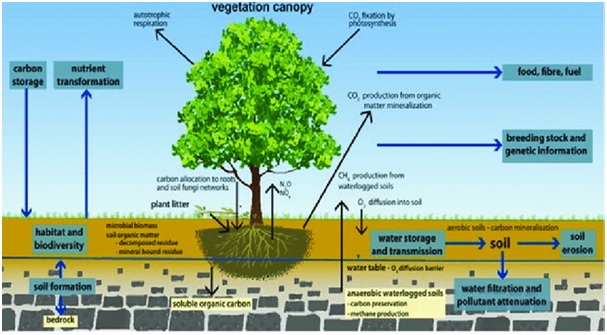Ecosystem services valuation: Correcting conceptual issues with carbon storage benefits
Valuation of ecosystem services has been the mainstay of natural capital assessments. However, the academic understanding in some of the scientific publications seems unsatisfactory.
Introduction
- Valuation of ecosystem services has been the mainstay of natural capital assessments. However, the academic understanding in some of the scientific publications seems unsatisfactory.
- Since these valuation mechanisms are used for facilitating compensatory payments for ecosystem losses, the lack of clarity in understandingaffects the policy space as well.
- Recently, it has become far more apparent that there are severalconceptual issues with the understanding of carbon stock and sequestration as an ecosystem service.
- Such aproblem has been continuing for quite some time and is highly prevalent in the existing literature on valuation of ecosystem services in general and values of carbon stock and sequestration in particular.
Ecosystem Services
- Basics:
- Ecosystem Services are the benefits that people derive from ecosystems.
- Every organism depends on other organisms for energy, survival, and other life processes. This dependence of organisms on one another and their surroundings forge an interacting system called ecosystems.
- As a part of ecosystem, humans derive lots of benefits from the biotic and abiotic These benefits are collectively termed as ecosystem services. Life and biodiversity on earth depend on these services.
- Facilitates:
- Besides provisioning services or goods like food, wood and other raw materials, plants, animals, fungi and micro-organisms provide essential regulating services such as pollination of crops, prevention of soil erosion and water purification, and a vast array of cultural services, like recreation and a sense of place.
Types of Ecosystem Services
- Provisioning Services -
- This includes the products/raw materials or energy outputs like food, water, medicines, wood, biofuels, and other resources from ecosystems.
- Further, they provide conditions for these resources to grow.
- Regulating Services -
- This includes the services which regulate the ecological balance.
- For example, terrestrial environments like forests purify and regulate air quality, prevent soil erosion, and control greenhouse gases.
- Wetlands provide fresh, clean water, regulate pollution, and reduce climate risk and uncertainty for people, agriculture and aquaculture (fisheries). Further, they are vital areas of biodiversity and are home to a vast range of animals, especially bird species.
- Biotic components such as birds, rats, frogs, act as natural controllers and thus help in pest and disease control.
- Supporting services
- Supporting services form the basis for other services.
- They provide habitat for different life forms, retain biodiversity, nutrient cycling, and other services for supporting life on the earth.
- Cultural services
- It includes tourism; provides recreational, aesthetic, cultural and spiritual
- Most natural elements such as landscapes, mountains, caves, are used as a place for cultural and artistic Some of them are even considered as sacred.
- Moreover, ecosystems provide enormous economic benefits in the name of tourism.

Stocks and Flows
- Ecosystem services have often been classified as stock and flow.
- Basics
- In economics and finance, the notion of “stock” is defined as the value of an asset at a particular point in time, while a “flow” refers to the total value of transactions that entail values of sales and purchases, incomes, productions, consumption, and investment expenditures during the period.
- The addition to stock is also delineated as a flow for the concerned period, e.g., new physical capital creation through infrastructure investments like new roads, bridges, or buildings.
- From the perspective of ecosystem services, stocks, therefore, should refer to the value that is stocked in natural resources but is not yet realised in the form of benefits, while flow benefits relate to the real flow of ecosystem goods and services.
- Example:
- The best example of stocks is that of timber stock in a forest. While the forest offers a host of services in the form of provisioning (e.g., felled timber, non-timber forest products, etc), regulating (e.g., carbon storage and sequestration), supporting (e.g., biological control, gene-pool protection), and cultural (e.g., tourism, spiritual); the standing timber stock is simply a store of value and does not enter into the human benefit function till felling happens.
- Therefore, flows are being valuedwhile placing an annual value to ecosystem services as monetised benefits obtained by the human community for a particular year.
- It needs to be kept in mind that the benefit to the human community or economy always occurs in the form of flows, though this flow may originate from a stock, e.g., the “natural capital” (biodiversity and natural assets) is a stock that provides us with a flow of benefits which are ecosystem services.
- Therefore, ecosystem services are not stocks, but flows.
Problems in ecosystem services interpretability

- Absence of Clarity: The inherent problem lies in the fact that the notion of ecosystem services are often not properly understood or interpreted.
- The Human Injection: Although ecosystem services are the services that the human community obtains from the ecosystem, it needs to be understood that these occur only at the interface of human society and the natural ecosystem.
- In that sense, ecosystem service is an “anthropocentric” concept.
- As per classifications of ecosystem services envisaged in the Millennium Ecosystem Assessment 2005, carbon absorption is a regulating service of the ecosystem.
Valuation of Ecosystem Services
- The Beginning:
- In 1997 Robert Costanza, an ecological economist, published a landmark paper on the concept of natural capital and the economic value of ecosystem services. He envisioned an economy in which ecosystem services are monetized.
- Various attempts have been made to calculate the combined value of these services. Costanza and colleagues estimated that ecosystem services amounted to $33 trillion per year in 1997 and an estimated $125 trillion per year in 2011.
- Prevent privatization:
- Costanza has suggested that ecosystem services must remain outside the market and should not be privatized.
- Accordingly, they must be managed as shared assets and assigned property rights by a government on behalf of its citizens according to the public trust doctrine.
- Climate change:
- Climate change has been treated as an externality and therefore not included in economic decision making.
- Accordingly, Sir Nicholas Stern, a lead author of the economic costs of climate change, referred to climate change as “the greatest market failure the world has seen.”

Challenges of Valuation of Ecosystem Services
- Economic barriers:
- Although Costanza’s work is now legendary among ecologists, monetizing ecosystem services and natural capital has been problematic.
- Various attempts to incorporate the value of the biosphere into Adam Smith’s concept of an economy driven by enlightened self-interest have met with theoretical and practical challenges.
- Since capitalism employs a cost vs. benefit approach, efforts to place a value on ecosystem services force their inclusion in decision making. Once acknowledged as valuable, ecosystem services should no longer be externalized.
- Estimation issues:
- Much of the difficulty with this concept comes from determining how to calculate the exchange value of a particular service with respect to other forms of goods and services.
- This issue becomes even more problematic when attempting to determine the cost of a particular transactionregarding lost natural capital and who should pay for this loss.
- Area and time variation:
- The exchange values of various ecosystem services vary from place to place and vary through time.
- Despite these difficulties, attempting to capture the value of presently ignored ecological processes represents progress.

The folly with carbon stock as an ecosystem service
- Overlapped carbon and timber stock:
- Certain scientific reports on valuation of forest ecosystem services value carbon stock as a stock benefit and juxtapose it with timber stock, treating them as conceptually identical.
- They are also being added to arrive at the stock value of the ecosystems whichis problematic.
- As stated, the timber stock value - product of total cubic metres of timber with its market price - is purely a store of value that may have a potential use in some other period.
- However, the carbon stock is not a store of value but provides a flow of value.
- The CO2 dilemma:
- Atmospheric CO2 is not a benefit (or service) to the humanity, but a cost (or disservice).
- It not only causes a host of negative impacts on the economy from the perspective of global warming, but also from the perspective of health costs, lowered productivities, and negative impacts on the GDP that the economy has to bear the cost of enhanced CO2 in the atmosphere.
- Therefore, it cannot have a price (as this is not a “good” that offers a positive “utility at the margin”), rather it isassociated with a cost that is imposed on the society.
- Forests as saviour:
- Forests sequester carbon in a process that removes carbon dioxide from the atmosphere. Through the process of photosynthesis, the carbon content - assumed to be 27 percent of CO2- gets stored by the forest, while the remaining 73 percent, i.e., oxygen (O2), gets released.
- The carbon is then stored in the forest within living biomass, soil, and litter and contributes to the forest carbon stock. This is a periodic process.
- In most studies on ecosystem service valuation, it is this sequestered carbon that is taken into account as a flow benefit, and not the carbon storage as a whole.
- Now, what one needs to note here is that the total carbon storage as also the newly sequestered carbon is a flow benefit! The carbon stock, if released from the forests, will add up to our “disutility.”
- Therefore, every moment or every year, the forest offers us the benefit of the stored carbon as also the sequestered carbon by helping us avoid the cost that the released carbon would have imposed on us.

The Social Cost of Carbon
- Significance:
- The importance of the Social Cost of Carbon lies in the fact that it attempts to reflect on all the potential quantifiable costs of emitting one additional tonne of CO2 in monetary terms.
- In that sense, this value reflects on the benefits of reduced atmospheric carbon through a cost saving approach.
- The beneficial forests:
- Correspondingly, the forest, which arrests the carbon, renders this value as a regulating service flow to the human community every year.
- The forest acts as a regulating reservoir at every moment in time by arresting the release of carbon to the atmosphere; thereby, helping society not to incur the cost.
- Every year, the stock of carbon already arrested in the forest and the addition to the stock arrived at through the quantity sequestered provide flow benefits.
- In other words, carbon’s negative value gets converted to a positive value every year through the retention of the existing stock and by addition to the stock through sequestration. Both entail ecosystem service flows.
- Price mechanisms:
- The Social Cost of Carbon emerges as a better price mechanism than the market price of carbon credits, which some reports and studies have often considered for valuation.
- Certified Emission Reductionor Verified Emission Reduction prices are subject to market fluctuations.
- During the economic boom prior to 2007, Certified Emission Reductionprices reached a peak, but completely lost momentum after the sub-prime crisis in the US and the economic slump in the EU.
- This was because of the slowing down of industrial activities whichhad resulted in a decline in demand for carbon credits.
- However, that does not imply that the damages from carbon emissions have declined or the values per unit of carbon sequestration by the forests have changed.
- Market prices are discovered on the basis of better information mechanism, and carbon markets are largely incomplete and imperfect.
- Therefore, if one needs to look at the opportunity cost of forest carbon, the mechanism to look at is the Social Cost of Carbon.
The biomass component as the basisfor ecosystem services valuation
- Including biomass component:
- It needs to be remembered that for valuation of forest ecosystem services, the biomass component should be taken into consideration while accounting for carbon storage benefits including sequestration. This is because of delineating the opportunity cost of forest degradation.
- The carbon stock generally consists of the total biomass - sum of above ground biomass (AGB) and below ground biomass (BGB) - deadwood, litter, and the soil organic carbon.
- Deadwood and litter generally constitutes a very small component (less than 0.5 percent) of the total carbon stock.
- Opportunity cost aspect:
- Generally, it is the carbon sequestration which is taken into consideration while conducting annual valuation considering that it is the only flow benefit.
- However, the more scientific way to look at the annual forest ecosystem service value is simply to look at the opportunity cost aspect.
- Forest destruction aspect:
- Hypothetically,if the forest is decimated from the face of the planet, what is lost is the total biomass stock including the newly sequestered component.
- There is no scientific evidence to state that the soil organic carbon will encounter any impact due to forest destruction.
- Therefore, in terms of valuing carbon stock as a regulating service, one needs to take into consideration the sum of above ground biomass and below ground biomass and multiply the same by the Social Cost of Carbon.

Conclusion
- Through the above arguments, it could be established that:
- ecosystem services are flows, not stocks, and carbon storage results in flow of benefits every moment
- social cost of carbon should be the basis of valuing the benefits
- ecosystem services of forests from carbon storage should be valued by taking total biomass, and leaving out soil carbon
- There is a critical need to correct our natural capital assessmentmethods with these aforementioned aspects.

